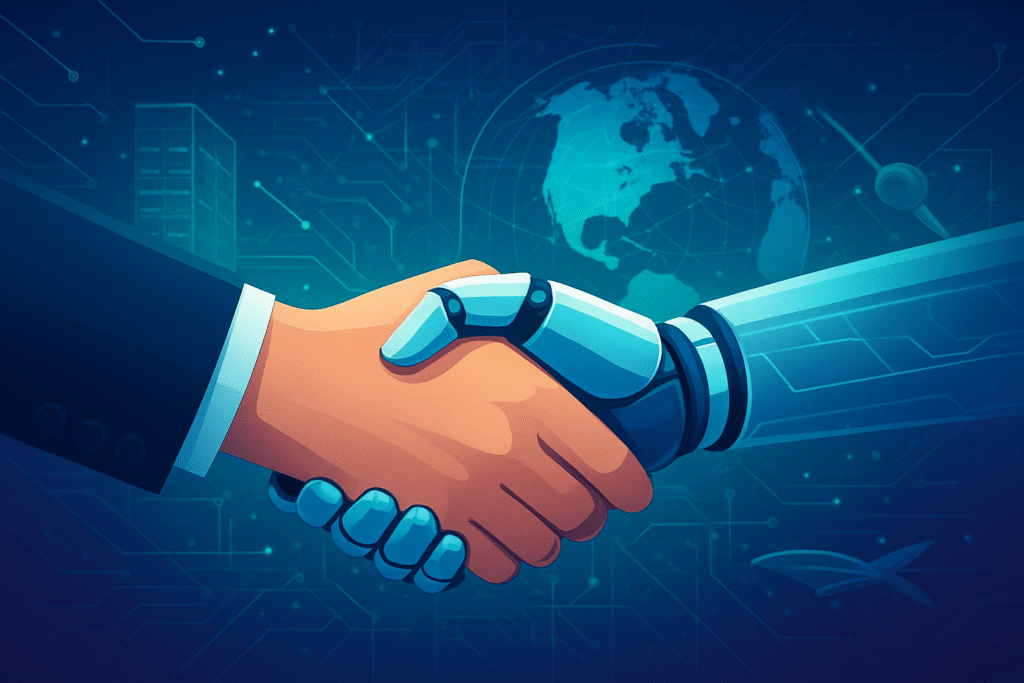
In an increasingly complex geopolitical landscape, governments worldwide are intensifying their engagement with business delegates to secure critical investments in the technology and defense sectors. This proactive and often interventionist approach, sometimes dubbed "geopolitical capitalism," signifies a profound shift in national economic and security strategies. The immediate significance of this trend, observed particularly acutely as of November 2025, lies in its potential to dramatically accelerate innovation, fortify national security, bolster domestic industrial capabilities, and stimulate significant economic growth.
This robust collaboration is not merely about traditional procurement; it represents a strategic imperative to maintain a technological and military edge. Nations are channeling substantial resources and political will towards fostering public-private partnerships, offering direct financial incentives, and providing clear demand signals to steer private capital into areas deemed vital for long-term national interests. The goal is clear: to bridge the gap between groundbreaking research and rapid deployment, ensuring that cutting-edge advancements in fields like AI, quantum computing, and cybersecurity translate swiftly into tangible strategic advantages.
A New Era of Strategic Investment: From AI to Critical Minerals
The current wave of high-level government engagement is characterized by an unprecedented focus on strategic investments, moving beyond traditional defense procurement to encompass a broader spectrum of dual-use technologies vital for both national security and economic prosperity. As of November 2025, this shift is evident in numerous initiatives across major global players.
In the United States, the Department of Defense's Office of Strategic Capital (OSC) released its Fiscal Year 2025 Investment Strategy, earmarking nearly $1 billion to attract and scale private capital for critical technologies. This includes credit-based financial products and clear demand signals to private investors. Furthermore, the U.S. has aggressively pursued critical mineral deals, securing over $10 billion with five nations by October 2025, including Japan, Malaysia, and Australia, to diversify supply chains and reduce reliance on adversaries for essential raw materials like rare earth elements and lithium. The Department of Energy (DOE) also pledged nearly $1 billion in August 2025 to bolster domestic critical mineral processing and manufacturing.
Across the Atlantic, the United Kingdom has forged a strategic partnership with Palantir (NYSE: PLTR) in September 2025, targeting up to £1.5 billion in defense technology investments and establishing London as Palantir's European defense headquarters for AI-powered military systems. The UK also committed over £14 million in November 2025 to advance quantum technology applications and unveiled a substantial £5 billion investment in June 2025 for autonomous systems, including drones, and Directed Energy Weapons (DEW) like the DragonFire laser, with initial Royal Navy deployments expected by 2027.
The European Union is equally proactive, with the European Commission announcing a €910 million investment under the 2024 European Defence Fund (EDF) in May 2025, strengthening defense innovation and integrating Ukrainian defense industries. A provisional agreement in November 2025 further streamlines and coordinates European defense investments, amending existing EU funding programs like Horizon Europe and Digital Europe to better support defense-related and dual-use projects.
Japan, under Prime Minister Sanae Takaichi, has prioritized dual-use technology investments and international defense industry cooperation since October 2025, aligning with its 2022 National Defense Strategy. The nation is significantly increasing funding for defense startups, particularly in AI and robotics, backed by a USD 26 billion increase in R&D funding over five years across nine critical fields.
NATO is also accelerating its efforts, introducing a Rapid Adoption Action plan at The Hague summit in June 2025 to integrate new defense technologies within 24 months. Member states committed to increasing defense spending to 3.5% of GDP by 2035. The NATO Innovation Fund (NIF), a deep tech venture capital fund, continues to invest in dual-use technologies enhancing defense, security, and resilience.
These initiatives demonstrate a clear prioritization of technologies such as Artificial Intelligence (AI) and Machine Learning (ML) for military planning and decision-making, autonomous systems (drones, UAVs, UUVs), securing critical mineral supply chains, quantum computing and sensing, advanced cybersecurity, Directed Energy Weapons, hypersonics, and next-generation space technology.
This approach significantly differs from previous national economic and security strategies. The shift towards dual-use technologies acknowledges that much cutting-edge innovation now originates in the private sector. There is an unprecedented emphasis on speed and agility, aiming to integrate technologies within months rather than decades, a stark contrast to traditional lengthy defense acquisition cycles. Furthermore, national security is now viewed holistically, integrating economic and security goals, with initiatives like securing critical mineral supply chains explicitly linked to both. Governments are deepening their engagement with the private sector, actively attracting venture funding and startups, and fostering international collaboration beyond transactional arms sales to strategic partnerships, reflecting a renewed focus on great power competition.
Shifting Sands: Tech Giants, Defense Primes, and Agile Startups Vie for Dominance
The unprecedented influx of government-secured investments is fundamentally reshaping the competitive landscape across the technology and defense sectors, creating both immense opportunities and significant disruptions for established players and nascent innovators alike. The global defense market, projected to reach $3.6 trillion by 2032, underscores the scale of this transformation, with the U.S. FY2025 defense budget alone requesting $849.8 billion, a substantial portion earmarked for research and development.
Tech Giants are emerging as formidable players, leveraging their commercial innovations for defense applications. Companies like Google (NASDAQ: GOOGL), Microsoft (NASDAQ: MSFT), Oracle (NYSE: ORCL), and Palantir Technologies (NYSE: PLTR) are securing lucrative contracts. Google's cloud platform, Google Distributed Cloud, has achieved Impact Level 6 security accreditation, enabling it to handle the most sensitive national security workloads, while Microsoft's OpenAI-enabled Azure offerings have been approved for top-tier classification. Oracle has strategically launched a "defense ecosystem" to support companies navigating Pentagon contracts. Palantir, alongside Anduril Industries, SpaceX, OpenAI, and Scale AI, is co-leading a consortium aiming to become a "new generation of defense contractors," collectively bidding for U.S. government projects. These tech behemoths benefit from their vast R&D capabilities, massive computing resources, and ability to attract top STEM talent, positioning them uniquely with "dual-use" technologies that scale innovation rapidly across commercial and military domains.
Traditional Defense Contractors are adapting by integrating emerging technologies, often through strategic partnerships. Lockheed Martin (NYSE: LMT), RTX (NYSE: RTX, formerly Raytheon Technologies), and Northrop Grumman (NYSE: NOC) remain foundational, investing billions annually in R&D for hypersonic weapons, advanced aerospace products, and next-generation stealth bombers like the B-21 Raider. Their strategic advantage lies in deep, long-standing government relationships, extensive experience with complex procurement, and the infrastructure to manage multi-billion-dollar programs. Many are actively forming alliances with tech firms and startups to access cutting-edge innovation and maintain their competitive edge.
A new breed of Startups is also flourishing, focusing on disruptive, niche technologies with agile development cycles. Companies such as Anduril Industries, specializing in AI-enabled autonomous systems; Shield AI, developing AI-powered autonomous drones; Skydio, a leader in autonomous AI-powered drones; and Saronic Technologies, building autonomous surface vessels, are gaining significant traction. Governments, particularly the U.S. Department of Defense, are actively supporting these ventures through initiatives like the Defense Innovation Unit (DIU), Office of Strategic Capital (OSC), National Security Innovation Capital (NSIC), and AFWERX. Programs like Small Business Innovation Research (SBIR) and Small Business Technology Transfer (STTR), along with "Other Transaction Agreements" (OTAs), help these startups bridge the "Valley of Death" in defense contracting, providing crucial funding for research, prototyping, and accelerated adoption. Their agility, specialized expertise, and often more cost-effective solutions offer a compelling alternative to traditional defense procurement.
The competitive landscape is witnessing the emergence of "neo-primes", where tech giants and agile startups challenge the long-held dominance of traditional defense contractors with software-centric and AI-driven solutions. This is fostering a "commercial-first" approach from the Pentagon, prioritizing the rapid adoption of industry-driven commercial solutions. Competition for specialized talent in AI, software engineering, and advanced manufacturing is intensifying, making robust R&D pipelines and a strong talent acquisition strategy critical. Furthermore, stringent cybersecurity requirements, such as the Cybersecurity Maturity Model Certification (CMMC) standards, are becoming mandatory, making robust security infrastructure a key differentiator.
This investment trend is also disrupting existing products and services. There's a clear shift towards software-defined defense, moving away from purely hardware-centric systems to modular architectures that allow for rapid upgrades and adaptation. The proliferation of autonomous warfare, from AI-powered drones to uncrewed vehicles, is redefining military operations, reducing human risk and enabling new tactics. These new technologies are often advocated as more cost-effective alternatives to expensive legacy platforms, potentially reshaping market demand. The emphasis on rapid prototyping and iterative development is accelerating innovation cycles, forcing all players to innovate faster. Finally, investments are also focused on supply chain resilience, boosting domestic production of key components to reduce dependence on foreign suppliers and ensuring national security in an era where the lines between physical and cognitive warfare are increasingly blurring.
A Geopolitical Chessboard: National Security, Economic Futures, and Ethical Crossroads
The intensified government engagement in securing technology and defense investments carries profound and far-reaching implications for national security, economic growth, and the delicate balance of global power dynamics. This trend, while echoing historical collaborations, is unfolding in a uniquely complex and technologically advanced era, raising both immense promise and significant ethical dilemmas.
From a National Security perspective, these investments are paramount for safeguarding nations against a spectrum of threats, both conventional and asymmetric. Strategic funding in areas like Artificial Intelligence (AI), unmanned systems, and advanced cybersecurity is critical for maintaining a competitive military advantage, enhancing intelligence capabilities, and protecting vital digital infrastructure. The emphasis on domestic production of critical components—from encryption algorithms to microchips—is a direct effort to reduce reliance on foreign suppliers, thereby fortifying national sovereignty and insulating economies from geopolitical shocks. A robust defense posture, underpinned by technological superiority, is increasingly viewed as a prerequisite for societal stability and freedom.
In terms of Economic Growth, government tech and defense investments serve as a powerful engine for innovation and industrial development. Historically, military R&D has been the genesis of transformative civilian technologies such as the internet, GPS, and radar. Today, this trend continues, with high-tech defense spending stimulating job creation, bolstering the industrial base, and creating a "crowding-in" effect that encourages further private sector investment. By ensuring a broad and reliable demand for new solutions, public commitment in defense innovation can spur private sector creativity and efficiency, contributing significantly to GDP growth and the expansion of the digital economy. However, this comes with the inherent "guns and butter" dilemma, where resources allocated to defense could otherwise be invested in education or healthcare, potentially yielding different long-term economic returns.
Globally, this surge in investment is undeniably redefining Global Power Dynamics. The race for AI leadership, for instance, is no longer merely an economic competition but a new geopolitical asset, potentially eclipsing traditional resources in influence. Nations that lead in AI adoption across various sectors gain significant international leverage, translating into stronger economies and superior security capabilities. This intense focus on technological supremacy, particularly in emerging technologies, is fueling a new technological arms race, evident in rising global military spending and the strategic alliances forming around military AI. The competition between major powers, notably the United States and China, is increasingly centered on technological dominance, with profound implications for military, political, and economic influence worldwide.
However, this accelerated collaboration also brings a host of Potential Concerns and Ethical Considerations. Within the tech community, there's a growing debate regarding the ethics of working on military and defense contracts, with employees often pushing companies to prioritize ethical considerations over profit. The misuse of advanced AI in military applications, particularly in targeting, raises serious questions about accuracy, inherent biases from deficient training data, unreliability, and the potential for exacerbating civilian suffering. Concerns also extend to privacy and surveillance, as sophisticated technologies developed for government contracts could be repurposed. The "guns and butter" trade-off remains pertinent, questioning whether increased military spending diversifies resources from other crucial sectors. Furthermore, large government contracts can lead to market distortion and concentration of innovation, potentially crowding out smaller players. The rapid and often opaque development of AI in military systems also presents challenges for transparency and accountability, heightening risks of unintended consequences. There's even an ongoing debate within Environmental, Social, and Governance (ESG) investing circles about whether defense companies, despite their role in peace and deterrence, should be considered ethical investments.
Comparing this to Historical Government-Industry Collaborations, the current trend represents a significant evolution. During the World Wars, industry primarily responded to direct government requests for mass production. The Cold War era saw the government largely in the "driver's seat," directing R&D that led to breakthroughs like the internet. However, the post-Cold War period witnessed a reversal, with the civilian sector becoming the primary driver of technological advancements. Today, while governments still invest heavily, the defense sector increasingly leverages rapid advancements originating from the agile civilian tech world. The modern approach, exemplified by initiatives like the Defense Innovation Unit (DIU), seeks to bridge this gap, recognizing that American technological leadership now relies significantly on private industry's innovation and the ability to quickly integrate these commercial breakthroughs into national security frameworks.
The Horizon of Innovation: AI, Quantum, and Autonomous Futures
The trajectory of high-level government engagement with technology and defense sectors points towards an accelerated integration of cutting-edge innovations, promising transformative capabilities in both public service and national security. Both near-term and long-term developments are poised to reshape how nations operate and defend themselves, though significant challenges remain.
In the near term (1-5 years), Government Technology (GovTech) will see a concentrated effort on digital transformation. This includes the implementation of "Trust-First" AI governance frameworks to manage risks and ensure ethical use, alongside a focus on leveraging actionable data and AI insights for improved decision-making and service delivery. Autonomous AI agents are expected to become integral to government teams, performing tasks from data analysis to predicting service needs. Cloud computing will continue its rapid adoption, with over 75% of governments projected to manage more than half their workloads on hyperscale cloud providers by 2025. Cybersecurity remains paramount, with federal agencies embracing zero-trust models and blockchain for secure transactions. The use of synthetic data generation and decentralized digital identity solutions will also gain traction.
Concurrently, Defense Investments will be heavily concentrated on autonomous systems and AI, driving a revolution in battlefield tactics, decision-making, and logistics, with military AI projected to grow from $13.24 billion in 2024 to $61.09 billion by 2034. Cybersecurity is a top priority for national defense, alongside substantial investments in aerospace and space technologies, including satellite-based defense systems. Advanced manufacturing, particularly 3D printing, will reshape the defense industry by enabling rapid, on-demand production, reducing supply chain vulnerabilities.
Looking further into the long term (beyond 5 years), GovTech anticipates the maturation of quantum computing platforms, which will necessitate proactive investment in post-quantum encryption to secure future communications. Advanced spatial computing and Zero Trust Edge security frameworks will also become more prevalent. For Defense, the horizon includes the widespread integration of hypersonic and Directed Energy Weapons (DEW) within the next 5-10 years, offering unparalleled speed and precision. Quantum computing will move beyond encryption to revolutionize defense logistics and simulations. Research into eco-friendly propulsion systems and self-healing armor is underway, alongside the development of advanced air mobility systems and the adoption of Industry 5.0 principles for human-machine collaboration in defense manufacturing.
The potential applications and use cases on the horizon are vast. In GovTech, we can expect enhanced citizen services through AI-powered chatbots and virtual assistants, streamlined workflows, and proactive public safety measures leveraging IoT sensors and real-time data. "Agentic AI" could anticipate issues and optimize public sector operations in real time. For defense, AI will revolutionize intelligence gathering and threat analysis, automate autonomous operations (from UAVs to swarm operations), and optimize mission planning and simulation. Generative AI is set to create complex battlefield simulations and personalized military training modules using extended reality (XR). Logistics will be optimized, and advanced communications will streamline data sharing across multinational forces.
However, realizing this future is not without significant challenges. For GovTech, these include overcoming reliance on outdated legacy IT systems, ensuring data quality, mitigating algorithmic bias, protecting citizen privacy, and establishing robust AI governance and regulatory frameworks. Complex and lengthy procurement processes, talent shortages in digital skills, and the need to maintain public trust and transparency in AI-driven decisions also pose substantial hurdles. The market concentration of a few large technology suppliers could also stifle competition.
In Defense, ethical and regulatory challenges surrounding the use of AI in autonomous weaponry are paramount, requiring global norms and accountability. Defense tech startups face long sales cycles and heavy dependence on government customers, which can deter private investment. Regulatory complexity, export controls, and the ever-increasing sophistication of cyber threats demand continuous advancements in data security. The cost-effectiveness of detecting and intercepting advanced systems like hypersonic missiles remains a major hurdle, as does ensuring secure and resilient supply chains for critical defense technologies.
Despite these challenges, experts predict a future where AI is a core enabler across both government and defense, revolutionizing decision-making, operational strategies, and service delivery. Geopolitical tensions are expected to drive a sustained increase in global defense spending, seen as an economic boon for R&D. The shift towards public-private partnerships and dual-use technologies will continue, attracting more venture capital. Defense organizations will adopt modular and agile procurement strategies, while the workforce will evolve, creating new specialized roles in AI ethics and data architecture, necessitating extensive reskilling. Cybersecurity will remain a top priority, with continuous advancements and the urgent need for post-quantum encryption standards. The coming years will witness an accelerated integration of AI, cloud computing, and autonomous systems, promising unprecedented capabilities, provided that challenges related to data, ethics, talent, and procurement are strategically addressed.
The Strategic Imperative: A New Chapter in National Resilience
The intensified high-level government engagement with business delegates to secure investments in the technology and defense sectors marks a pivotal moment in national economic and security strategies. This proactive approach, fueled by an understanding of technology's central role in global power dynamics, is rapidly transforming the innovation landscape. The key takeaways from this trend are multifaceted: a clear prioritization of dual-use technologies like AI, quantum computing, and critical minerals; a significant shift towards leveraging private sector agility and speed; and the emergence of a new competitive arena where tech giants, traditional defense contractors, and innovative startups are all vying for strategic positioning.
This development is not merely an incremental change but a fundamental re-evaluation of how nations secure their future. It signifies a move towards integrated national security, where economic resilience, technological supremacy, and military strength are inextricably linked. The historical model of government-led innovation has evolved into a more interdependent ecosystem, where the rapid pace of commercial technology development is being harnessed directly for national interests. The implications for global power dynamics are profound, initiating a new technological arms race and redefining strategic alliances.
In the long term, the success of these initiatives will hinge on addressing critical challenges. Ethical considerations surrounding AI and autonomous systems, the complexities of data privacy and bias, the need for robust regulatory frameworks, and the perennial issues of talent acquisition and efficient procurement will be paramount. The ability of governments to foster genuine public-private partnerships that balance national imperatives with market dynamics will determine the ultimate impact.
As we move through the coming weeks and months, observers will be watching for further announcements of strategic investments, the forging of new industry partnerships, and the progress of legislative efforts to streamline technology adoption in government and defense. The ongoing dialogue around AI ethics and governance will also be crucial. This era of high-stakes investment is setting the stage for a new chapter in national resilience, where technological prowess is synonymous with global influence and security.
This content is intended for informational purposes only and represents analysis of current AI developments.
TokenRing AI delivers enterprise-grade solutions for multi-agent AI workflow orchestration, AI-powered development tools, and seamless remote collaboration platforms.
For more information, visit https://www.tokenring.ai/.





